Primary forests in Europe
Of all the great forests described by the classic authors, Europe only has a few left standing. Reduced to a small number of hard-to-define pockets and disappearing sanctuaries, Europe’s primary forests have all but vanished from the continent. But a few diehards are giving fresh hope and mobilising new preservation efforts.
Where are Europe’s primary forests?
Reporting on his expedition to the continent for the Gallic Wars in 54 BC, Julius Caesar himself marvelled at the sheer scale of the intact Hercynian (Central Europe) and Ardennes (France, Belgium, Germany) forests. Corroborated on numerous occasions by other Roman writers, his notes attest to the presence of European forests that remained protected from logging and agriculture.
Two thousand years on, the FAO (Food and Agriculture Organization of the United Nations) estimated that the surface area of Europe’s primary forests in 20201 stood at just over 4,000 hectares, or just 3% of the continent’s forests. When we include Russia, that figure rises to almost 260,000 hectares, with the country home to almost 97% of Europe’s primary forests.
But counting up hectares of remaining primary forest is far from child’s play. Arguments over definitions and counting methods, a lack of credible data for certain regions and rapidly changing situations on the ground all mean arriving at a precise figure that can achieve consensus remains a challenge. However, the European Commission has made protecting primary forests one of its priorities in its Biodiversity Strategy for 20302. Now onto the tricky task of finding them...
After collecting colossal amounts of data and cross-checking their efforts, in 2021, the European Commission’s Joint Research Centre produced a map of Europe’s primary and old-growth forests, alongside a report on the degree to which they’re protected3. Although their findings have to be viewed with a certain degree of caution – especially because of the differences in definitions between countries and the absence of data for certain areas – it nevertheless provides an overview of what remains of these treasure troves of biodiversity.
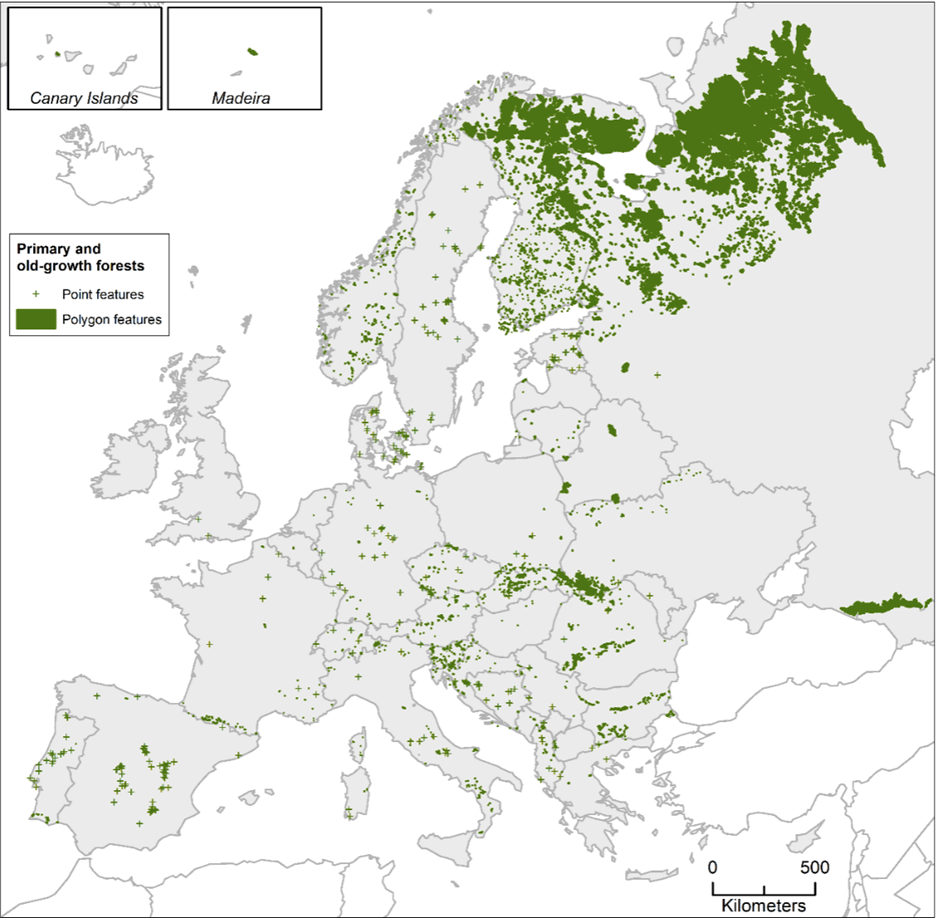
Fragmented and divided, Europe’s primary forests are mere shadows of their former glory. Lots of these little pockets of biodiversity now only have the “character” of primary forests in certain places, jeopardising their ecological continuity, the irreplaceable ecosystem services they provide, as well as the survival of the flora and fauna they shelter.
A few significant areas remain, particularly in the boreal regions of Russia and Finland. One of the most symbolic resistance fighters is the Białowieża Forest, which straddles the Polish-Belarussian border, a last outpost of the Hercynian forest Cesar would have gazed upon, which is also home to the last bison in Europe. Officially designated as a UNESCO World Heritage Site since 1979 and classified as a biosphere reserve since 1976, it extends over more than 140,000 hectares and has been an immutable witness to our history, from the wanderings of classic authors to hunts led by Roman emperors, all the way up to the breakup of the USSR, the treaty for which was actually signed in the Belarusian part of the forest in 1991.
1 FAO. 2021. Évaluation des ressources forestières mondiales 2020: Main report. Rome.
2 European Commission, Directorate-General for Environment, EU biodiversity strategy for 2030 – Bringing nature back into our lives, Publications Office of the European Union, 2021.
3 Barredo, J., Brailescu, C., Teller, A., Sabatini, F.M., Mauri, A. and Janouskova, K., Mapping and assessment of primary and old-growth forests in Europe, EUR 30661 EN, Publications Office of the European Union, Luxembourg, 2021, ISBN 978-92-76-34230-4, doi:10.2760/797591, JRC124671.
Primary forests in France
Despite its 17.3 million hectares of forest4, mainland France isn’t home to a single primary forest, at least not under the definition adopted by the FAO, a very sad observation. A number of areas could be assimilated and scaled up, as outlined in a European Union report, which estimates the total area of forests undamaged by human activity in the country could amount to approximately 12,000 hectares. But their existence remains elusive, an echo of a long-vanished past.
There are plenty of so-called “ancient” forests in France, but their age doesn’t attest to their quality in terms of biodiversity or ecosystem resilience. This category also includes secondary forests (those that have been regenerated after being exploited), as well as those currently being used for logging or agriculture. The Réserves Naturelles de France network manages 7,500 hectares of “natural” forests5, which haven’t been subject to human activity for at least 50 years. But these are only in the very early stages on the way to “primarisation”.
You have to leave mainland France to find the only remains of any truly primary forests in a French territory and head to Guyana, with over 7 million hectares of primary forest, or 95% of its forest cover6. But this too is visibly diminishing in the face of the combined greediness of logging and mining.
4 National Forest Inventory, 2023 memento. IGN
5 Book 7 -Nature Reserve Forest Heritage – Focus on natural forests. Réserves Naturelles de France. November 2017
6 FRA 2020 Report, Guyane
Europe’s primary forests
Just as alarming as being wiped off the map entirely, the continent’s few surviving primary forests face numerous threats and a veritable mish-mash of protection measures. Though they require the highest level of conservation efforts to ensure their survival, their degree of protection varies greatly from one country to the next, and the systems put in place are just as disparate. Some fall under Natura 2000 zones, while others are classed as national or regional parks. Some are designated as UNESCO biosphere reserves, while others are known as integral biodiversity reserves (a status typically used in France, where there are currently 727 in mainland France). Each status is achieved through different criteria and regulate different activities. Few places are truly protected against human activity or logging (yes, even in national parks!) and there aren’t many legal mechanisms to prevent them from being damaged.
In the Białowieża Forest, for example, the Polish government ordered the felling of 180,000m3 of trees over a decade back in 2016, something that was immediately blocked by the Court of Justice of the European Union, which ordered a halt to the logging, with Poland facing a penalty of €100,000 per day in the event of failing to comply with the order to stop8 . In 2022, amidst the war in Ukraine and fears about the potential for the conflict to spread, the Polish government erected a 187km “anti-migrant” fence in the middle of the forest along the Belarusian border, creating an irreparable ecological divide..
But the future isn’t set in stone for Europe’s primary forests! Conservation efforts are intensifying and preserving these irreplaceable ecosystems now stands among the top priorities for a European Union determined not to let them disappear altogether. At the same time, some encouraging initiatives are beginning to flourish, particularly the Francis Hallé Association’s plan to create a 70,000 hectare primary forest in Europe, where the only effort involved is keeping our hands off it for centuries...
7Data published by France’s National Forest Agency https://carmen.carmencarto.fr/105/ONF_Forets.map
8 Le Monde, 22 November 2017, 1…
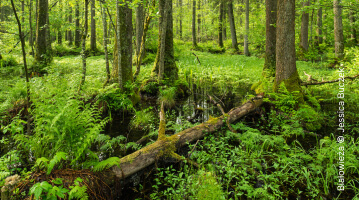
What is a primary forest?
Incredible sanctuaries of biodiversity and model ecosystems, primary forests are among the last places on Earth not yet disturbed by human activity. Without even knowing it, they’re an essential part of the chain that makes life on Earth possible, and they deserve our full attention!
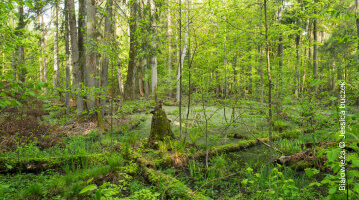
Other primary forests around the world
Whether boreal, temperate or tropical, primary forests still cover a few magical parts of the planet. But their surface area is continuing to dangerously decrease...
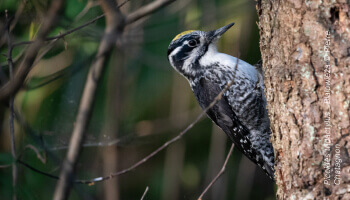
Different types of forests
Primary, secondary, natural, ancient, virgin or primitive... we’ll help you understand all the different categories of forest.
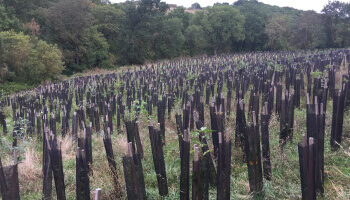
Creating a primary forest
What’s the recipe for recreating intact forests with abundant biodiversity? Do absolutely nothing... or rather, leave nature to get on with it!
